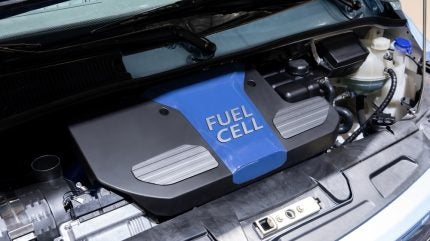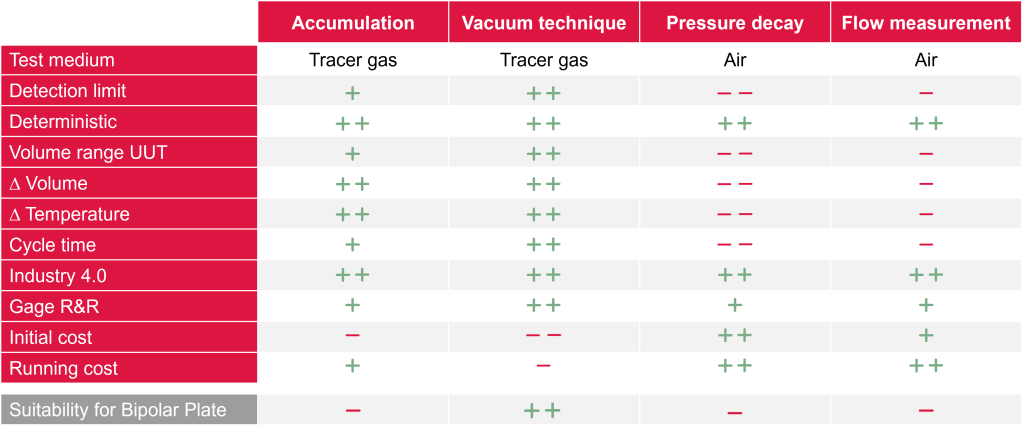
As the need for clean energy rises, the emerging technology behind hydrogen fuel cells becomes ever more important to the future of the environment. Using the most abundant element in the universe as fuel, hydrogen fuel cells combine hydrogen and oxygen to generate electricity. The process offers exceptional energy efficiency as well as an environmentally friendly, zero-emission alternative to burning fossil fuels.
Considering the dangers of hydrogen, safety will be paramount in the commercialisation of this game-changing technology. As such, numerous parts must undergo leak detection tests to ensure acceptable levels of tightness in the system. If this test cannot detect a process-relevant leak, there could be major repercussions for the manufacturer.
In a recent webinar, two application experts from Pfeiffer Vacuum joined forces to discuss the importance of leak testing and how to optimise an industrial leak test for the industry.
“All the typical H2 components that we see – the electrolysers, the fuel cells, the bipolar plates, the tanks – they all require a leak test at some point in the manufacturing process, and the main driver for this leak testing is safety,” says Dr Baptiste Chatelain, Market Manager Industrial Leak Testing, Pfeiffer Vacuum. He adds that the reliability of the system and the global warming potential of a gas leak are further compelling reasons to implement a leak test: “We want to prevent any harm to the environment, which is the main goal of the hydrogen economy.”
The evolution of leak testing in the H2 economy
With safety the main motivation behind the test, high levels of caution have defined the leak detection recipes used by the industry for many years. The generally valid safety-driven approach to leak testing has now been supplemented by a conservative functional approach. Let us illustrate this using the example of bipolar plates as functional units of fuel cell stacks.
In the early stages, manufacturers wanted to test all the potential leak paths of a single bipolar plate, amounting to a time-consuming total of ten individual tests. This included bidirectional tests of the media channels, the escape to the atmosphere from each individual channel, and the sum of all these channels to the exterior.
This approach has since evolved, says Dr Rudolf Konwitschny, Leak Detection Application Engineer, Pfeiffer Vacuum: “First, people found that it was sufficient to do unidirectional measurements for individual media channels. Now, we are on the verge of implementing this technology into medium to mass-scale production, so the pressure on cycle time is growing. People are trying to combine tests in an intelligent way or make groups of tests to save cycle time.”
While test recipes may be evolving, the same cannot currently be said for regulations. The guidance does not offer precise pass/fail criteria, nor any rules on testing methods or test parameters. Currently, the most relevant guidance comes from the DIN EN IEC 62282-2 norm for fuel cell modules, which states a leakage rate of no more than 5cm3 /min for the entire fuel cell. This can be equated to approximately 5.0·10-5 mbarl/s for a single bipolar plate.
According to Dr Konwitschny, the lack of clear guidance has left manufacturers free to choose from a wide range of options, though not every method is well-suited to the application. One poll taken during the webinar revealed 71% of attendees are using a vacuum test with tracer gas, while 14% opt for a pressure decay test, 7% for accumulation with tracer gas, and 4% for the bubble test. When asked about their maximum allowable leak rate, the majority was lower than 10-3 mbar l/s. However, 32% said their rate was not yet determined, and 7% stated they did not know.
“This clearly reflects that we are in an emerging industry, with emerging solutions for this technology,” noted Dr Konwitschny.
What is the best leak test for bipolar plates?
With an array of leak testing methods available, the process of selecting a method can be daunting. Many different criteria must be considered in order to select the right method for the right application, says Dr Chatelain.
“We have to start with some kind of preselection process,” he advises. “Do I need a pass/fail criterion with quantitative measurement, or do I need to localise the leak? I need to also consider the working condition in terms of gas flow direction – is it flow-out or flow-in? There is a common rule in the industry of leak testing that we need to test with the same conditions that we are experiencing in real life.”
Once the criteria for a quantitative measurement have been accounted for, it is easy to eliminate non-applicable methods such as sniffing, spraying or bubble tests, which can only localise leaks. The next step considers product-related characteristics such as the part’s volume, material, and connections for pressurisation/evacuation during the cycle. After this, manufacturers have four potential leak test methods: accumulation with tracer gas, vacuum technique with tracer gas, pressure decay, and flow measurement.
To further evaluate, it’s necessary to consider any environmental conditions that could influence the results, including ambient temperature, uncontrolled flow, and background pollution, as well as test requirements.
“What is the maximum permitted leakage rate? This often comes from the regulation, but sometimes manufacturers require even stricter limits. We also have to determine the test pressure and the constancy of the temperature and volume,” says Dr Chatelain.
This must be balanced against industry-driven requirements, including the initial capital investment, its running costs, compatibility with Industry 4.0, and speed.
“The dream is to have one bipolar plate per second falling off a production line, and we need to implement a technology that can do this with a minimum number of parallel stations,” says Dr Konwitschny.
The table below compares the four methods against these key parameters, with the vacuum tracer gas technique outperforming other methods on everything but cost.

The latest development for leak testing bipolar plates
At the end of the webinar, the two speakers introduce Pfeiffer Vacuum’s latest patented development for the fuel cell industry, a Bipolar Plate Leak Test Module which deploys a unique approach to achieving fast cycle times.
Discussing its unique advantages, Dr Chatelain says: “It has the advantage to be fast, with a short cycle time due to our innovative process. It offers flexible testing due to a unique lid mechanism, which allows different thicknesses to be tested without set-up time, and it is fully modular, which means it can be completely integrated in a production line.”
Pfeiffer Vacuum provides industry-leading leak detection solutions across every industry. With its latest development for fuel cells, it is looking to revolutionise the industrial leak testing landscape, addressing the challenges faced in industrial bipolar plate production to bring the world one step closer to the hydrogen economy.
To learn more about leak testing requirements for this industry and the new solution from Pfeiffer Vacuum, download the full webinar below.


